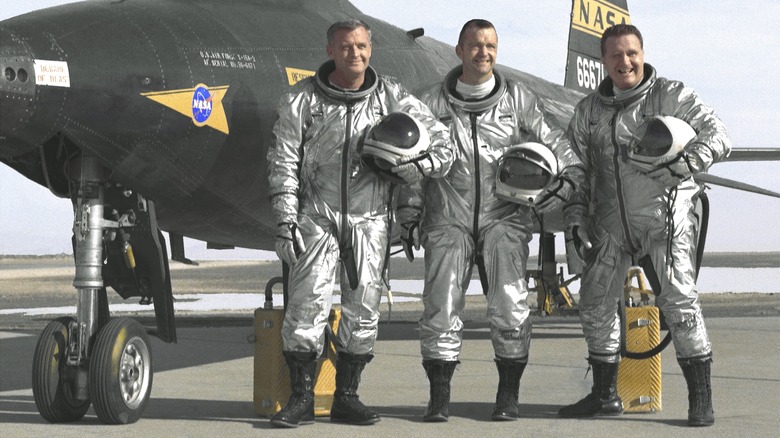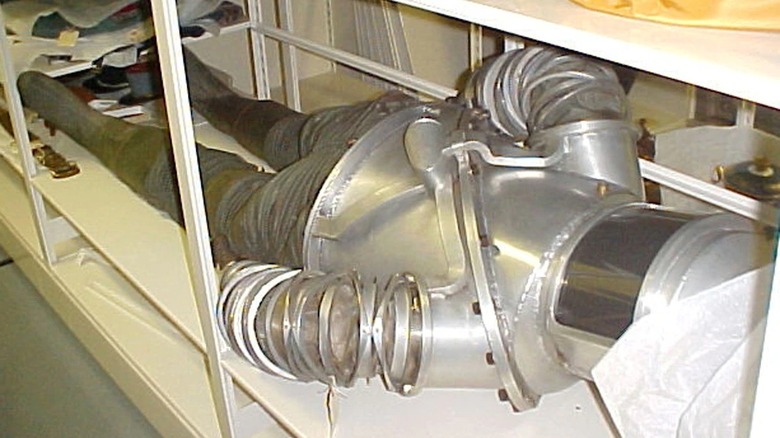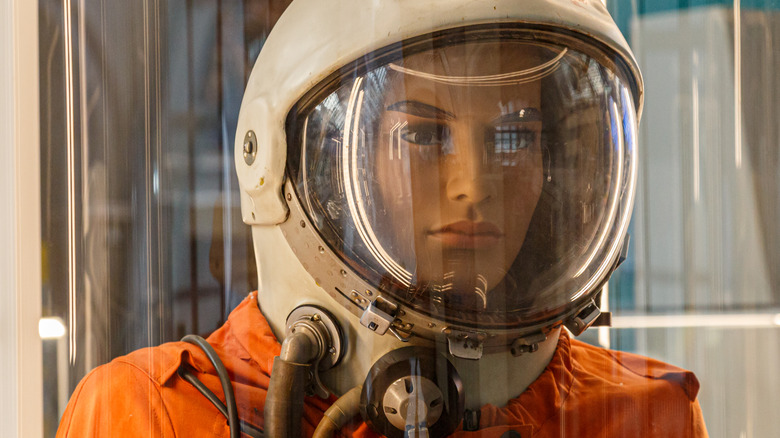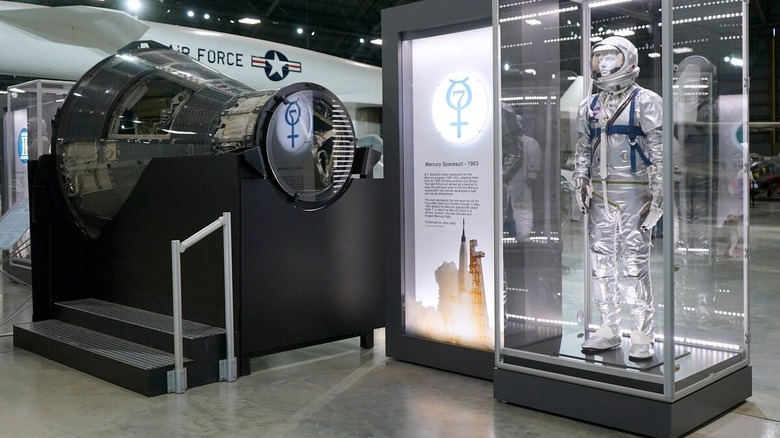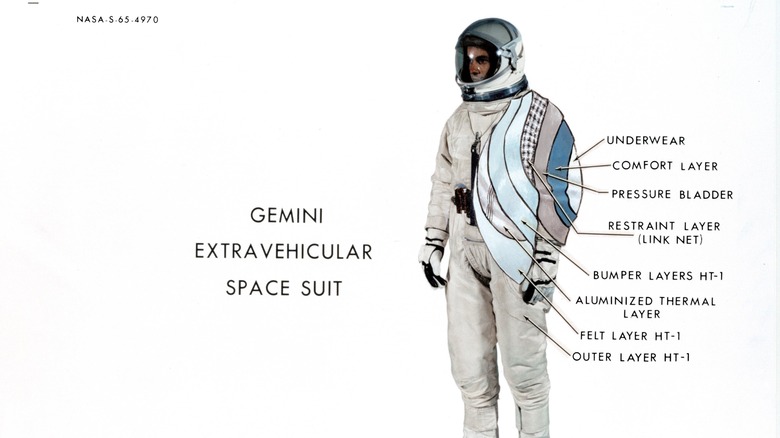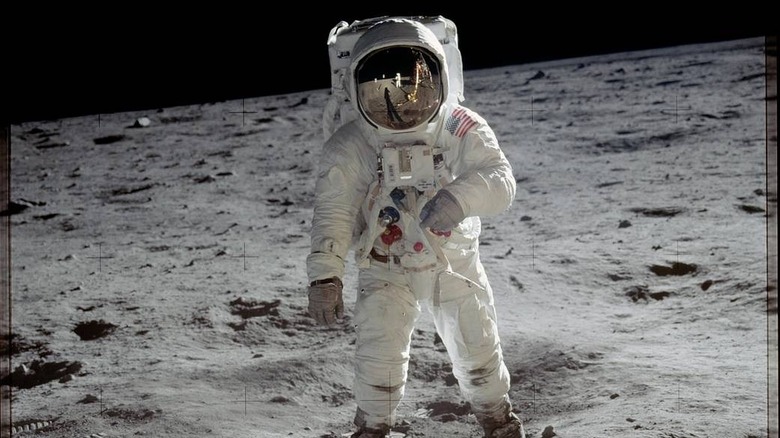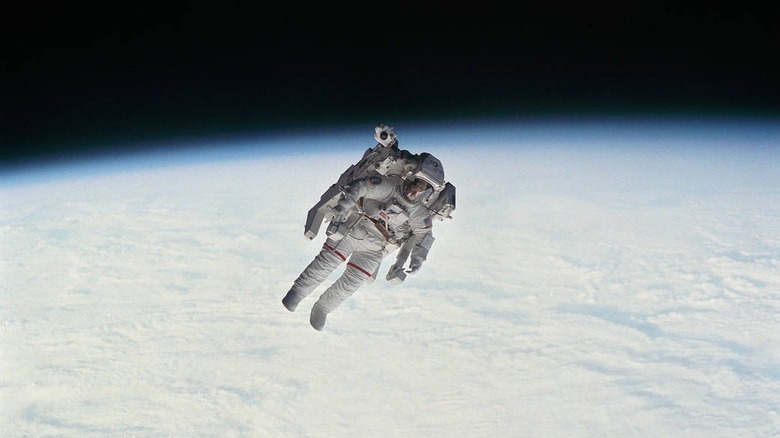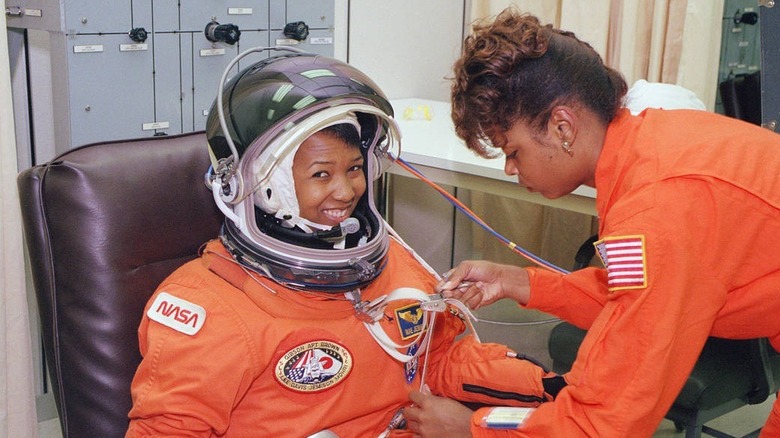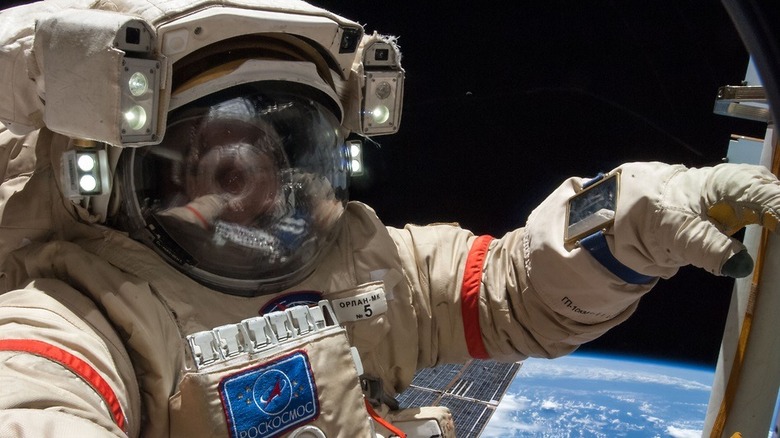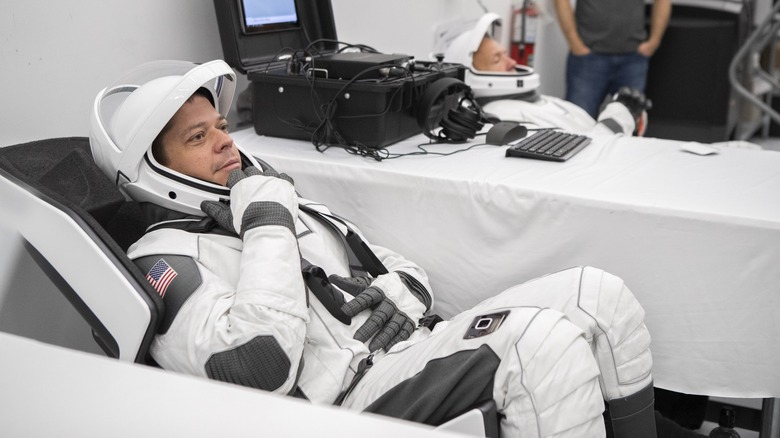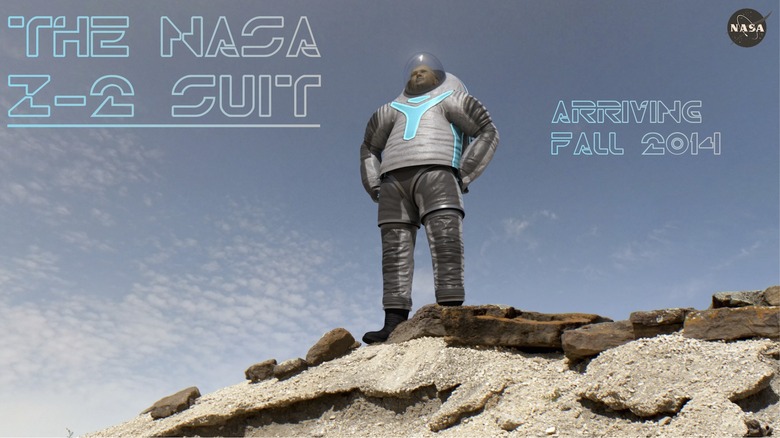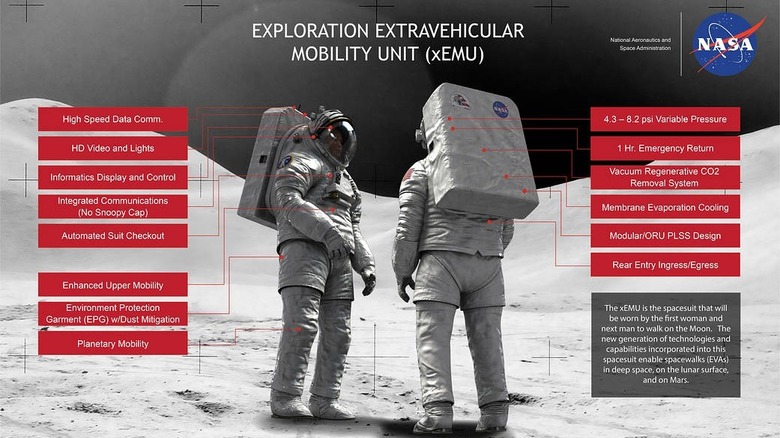The Evolution Of Space Suits Explained
For most of our history, we didn't have to worry all that much about wearing suits to adapt to our environment. Evolution is pretty good at building animals in such a way that they're at least moderately comfortable wherever they live. It would be a pretty poor system of biology otherwise. Then we got these big brains and started moving around the world. Suddenly we found ourselves in environments wholly different from the ones we evolved in. We had to invent clothing which, from a certain point of view, were the first environmental suits. Later, we decided the surface of our planet wasn't enough for us and all bets were off.
Venturing underwater or even into the air requires specialized clothing to maintain the right pressure and atmosphere for us to survive. Venturing into space is a different ball game altogether. Space is a wholly unfriendly place, lacking all of the qualities of the planet we call home. That means astronauts need to take everything they need to survive with them. Their suits provide temperature protection, oxygen, and atmospheric pressure to keep their bodies relatively happy.
As our understanding and relationship with space has evolved and expanded, so too have our space suits and we're just getting started.
Early pressure suits
The need for a pressure suit begins long before you actually leave the Earth's atmosphere. Anyone who has ever gone for a drive into the mountains or even across the country has noticed the signature popping in the ears as the pressure gets lower or higher. Those problems are only exacerbated by pilots flying at high altitudes and pressure suits were quickly needed to keep them safe.
As explained by NASA, pilots flying at 43,000 feet or greater were subject to intense environmental changes as compared to ground level. The temperatures could reach a frigid negative 66 degrees Fahrenheit and the air pressure was so low that they couldn't get sufficient oxygen. As a result, the first functioning partial pressure suits were developed in 1946 and were used by the United States Air Force.
Those early suits were dubbed the S-1 or the Henry Suit. They were fairly rudimentary and not intended for extended use. Instead, partial pressure suits worked by putting active pressure on the body either through tight non-breathable fabric or a series of bladders. They would activate only in the event of depressurization inside the aircraft. They were intended to buy pilots time to get to a safe altitude without losing consciousness.
While they wouldn't be useful in the near-vacuum of space, these first pressure suits laid the groundwork for what would become modern space suits.
Litton Mark I
Even before the space race really kicked off, the United States Air Force, in partnership with Litton Industries, got to work on a suit that could work at altitudes in excess of 100 miles. The suit's full name was the USAF Mark I Extravehicular and Lunar Surface Suit, and it was tested between 1958 and 1959 for approximately 600 total hours (via National Museum of the United States Air Force).
Of course, at the time, Sputnik hadn't even launched yet and humanity wasn't in a position to actually put a person or even an uncrewed object like a pressure suit 100 miles into the air. Instead, as explained by Astronautix, researchers simulated the conditions of the atmosphere (or lack of it) at that height.
The suit itself looks a bit like a tin can with some hosing for arms, but it had a surprisingly good range of motion and did the job it was designed to do, namely keeping pressure for any human being wearing it.
Ultimately, the Mark I ELSS never got its day in space. By the time we were ready to send humans off-planet, better suits had been designed, but we might never have reached that point without the foundational work achieved with this suit.
Russian SK-1
By 1961, the space race was in full swing. The United States and the Soviet Union had both launched satellites, and the next logical step was putting a person in orbit. That was accomplished in 1961 when the Soviets launched Yuri Gagarin into space aboard Vostok 1, (via NASA).
On that fight, Gagarin wore the SK-1 space suit which is, in many ways, the first true space suit as it was the first to be worn by a human being in space. The SK-1 was a full pressure suit designed to keep Gagarin alive under a wide array of conditions. He, of course, was going to be in space with the potential for a loss of pressure in a near-vacuum but he also had to survive a precarious re-entry. Vostok was designed to eject Gagarin seven kilometers above the surface and allow him to float back to the ground with the aid of a parachute.
With all of that in mind, his suit included life support systems, a visored helmet, a radio headset, and an inflatable collar which would come in handy in the event of a water landing, doubling as a life preserver (via Space Race). The suit performed admirably, as did Gagarin, cementing both in the history of space travel.
Mercury suit
In the wake of Gagarin's successful flight, the United States was rushing to get their own astronauts into space via the Mercury program. They would succeed just a few weeks later. In preparation for the Mercury program, NASA utilized a suit derived from US Navy aviation suits (via National Museum of the United States Air Force).
The Mercury suits were silver in color, owing to an aluminum coating on the fabric, designed to reflect heat. Most of the temperature control, however, was handled by the spacecraft itself. Like many of the previous pressure suits, the Mercury suit was intended as a failsafe in the event of pressure loss during a mission. All told, it was comprised of only two layers, the outer suit layer and an internal layer of long underwear which helped with circulating air.
Each suit was tailor-made for the individual astronaut and fit snuggly. Gloves, boots, and a helmet were attached to the suit by way of rings at the wrists, ankles, and neck, (via NASA). External hoses fed to a portable ventilation system and connected at the waist.
As the program progressed, adjustments were made to the suit, improving its functionality. That philosophy would continue throughout future NASA programs.
Gemini suit
Gemini marked a step up in terms of mission objectives. While no Mercury mission lasted more than a day and a half, multiple Gemini missions orbited for several days, and Gemini VII orbited for just shy of two weeks. The extended mission length as well as EVA activities necessitated enhancements to NASA's suite of space suits.
By the time we reached Gemini, suits began to look more like the ones we're familiar with today, even taking on the familiar white coloration we would later see during Apollo. Because Gemini astronauts would be spending time outside of their spacecraft, the suits needed to have additional protections built in. That was accomplished through a series of layers, each with specific tasks. As illustrated by NASA, the Gemini Extravehicular Space Suit was comprised of eight layers which included underwear, a comfort layer, a pressure bladder, a restraint layer, bumper layers, aluminized thermal layers, a felt layer, and the outer layer.
Hoses attached to the suit delivered cooling and air circulation. The suits were also outfitted with communications technologies and biomedical instruments. During space walks, they could also make use of a gold-plated visor for blocking unfiltered sunlight and life support backs which attached to the chest and back.
Apollo suit
This is perhaps the most famous spacesuit of all time. It's up there among the most famous and historically important pieces of clothing ever made. This is the one that walked on the Moon. For the Apollo missions, astronauts had to complete activities inside a spacecraft as well as carry out the first extravehicular activities on another world. That brought the unique challenge of crafting a suit that could handle the extremes of a vacuum while also interacting with the ground.
As explained by How Stuff Works, this was achieved by crafting a single suit with attachable accessories for specific actions. The Apollo suit had a water-cooled undergarment and a pressure suit made of multiple layers. Once again, an aluminum coating was used to achieve heat reflection.
Once on the Moon, astronauts attached additional layers onto the boots and gloves to handle coming into contact with the lunar surface. They also used specialized visors to protect Moon walkers from unfiltered sunlight. While inside the Apollo craft, oxygen and pressure were provided by way of an umbilicus connected to the ship, but during lunar activities, they used a life support backpack.
Neil Armstrong's suit recently underwent an extensive restoration and is currently housed in the Smithsonian's National Air and Space Museum. For a closer look, you can play around with a 3D model of the suit, courtesy of the Smithsonian.
MMU
Technically speaking, the MMU (short for Manned Maneuvering Unit) is not a space suit, but we'd be remiss in talking about the evolution of suits without mentioning it. The MMU was an accessory attachment first deployed during the Space Shuttle era, in 1984. It allowed an astronaut on a spacewalk to freely maneuver in space, detached from any spacecraft.
It was designed with satellite rescue missions in mind, (via NASA) but was only ever flown three times, during the tenth, eleventh, and fourteenth shuttle missions. Bruce McCandless had the honor of that first flight.
The MMU took inspiration from previous devices like the M509 backpack which had been tested in Skylab. It was, for all intents and purposes, a very small spacecraft lacking any enclosure or pressure, more akin to a space motorcycle than a car, which an astronaut could strap into and fly around untethered in space.
The MMU achieved propulsion from two tanks of nitrogen gas which could be released from various outlets via hand controls. Despite it being among the coolest things we've ever done in space, it was ultimately retired. Today, astronauts wear the SAFER unit (Simplified Aid For EVA Rescue), which pairs down the MMU's capabilities to a small backpack worn during EVAs (via NASA).
Shuttle suit
Astronauts flying aboard the Space Transportation System, more commonly known as the space shuttle, were often seen wearing what became colloquially known as the pumpkin suit. The orange-colored suit's official moniker was the Launch and Entry Suit (LES) and was intended to protect astronauts from near-vacuum as well as from cold temperatures of the ocean. The idea behind the suit was that it would maintain temperature and pressure in the event of a high-altitude bailout. Astronauts could then parachute back to the Earth's surface where they would have a high likelihood of a water landing.
It was used between 1988 and 1994, ending with STS-64. Despite being newer than the previous EVA and lunar suits, it had more in common with the high-altitude aviation pressure suits of previous generations. In fact, they were provided by the David Clark company which was previously responsible for the Gemini suits.
As explained by Space Center Houston, instead of the full pressure of previous suits, the LES was partial pressure and had air-filled bladders placed between the astronaut and the suit's outer layer. Those bladders would provide direct pressure on the body to simulate the atmosphere. An inflatable around the neck sealed the head off from the rest of the body so oxygen could fill the helmet without filling the rest of the suit. Ultimately, the LES was replaced by the Advanced Crew Escape Suit, which was full pressure and more comfortable.
Russian Orlan suit
The Orlan series of suits are among the coolest ever made and were recently popularized in Andy Weir's "Project Hail Mary." It was derived from the previous Kretchet suit, which had been intended for use on the lunar surface, but never got the chance.
The Orlan was designed and used by cosmonauts during EVAs on space station missions as early as Salyut and carried through to Mir and the International Space Station. Unlike other suits which have detachable gloves, boots, and helmets, the Orlan was a single-piece design with flexible limbs and a rigid body, (via Astronautix). Instead of slipping into the suit and then attaching peripheral, cosmonauts entered the suit through an opening in the back like an insect shedding in reverse.
Because it was an all-inclusive design, there were no external hoses save for an attached umbilical cord which provided electricity and communications from the space station. The earliest versions were limited to three hours of EVA time, but later versions increased that to nine. A control panel perched on the suit's chest with markings in reverse, which cosmonauts could view via a mirror on the wrist. The Orlan is still in use by cosmonauts on the International Space Station today and continues to be updated (via Space Foundation).
SpaceX Suit
When Crew Dragon Demo-2 lifted off in May of 2020, there was plenty of excitement to go around. It was the first crewed launch from the United States since the shuttle was retired nearly a decade earlier. Despite that, the public was enamored by the flashy new space suits Doug Hurley and Bob Behnken were wearing.
The suits, designed by SpaceX, looked more like what you might expect to see in a movie than in a real-life spaceflight. Like many of the suits that came before them, they were designed and tailored specifically for the astronauts wearing them, making them easier to get in and out of in the microgravity environment of low-Earth orbit (via Space).
When sitting, the suits plugged directly into the ship for the delivery of oxygen and pressure. While the SpaceX launch and re-entry suits were not intended for spacewalks, they could hold pressure in the event of cabin depressurization. They also had gloves that could work with the ship's touchscreen.
While Demo-2 was the mission that made the suits famous, that wasn't actually its first time in space. The suit was launched on previous test missions leading up to Demo-2, including the uncrewed Demo-1 flight.
Z series
As humans prepare to venture into the vastness of space yet again, the Moon and beyond, NASA is once again revisiting the space suit and designing new versions for future missions. The current slate of suits is designed for launch and re-entry to and from Earth, as well as the microgravity environment of low-Earth orbit. One thing we've learned in over 50 years of human activities in space is that the suit needs to fit the activities expected of it. Getting boots on the Martian ground means designing a suit for the unique characteristics of the red planet.
NASA has contracted with ILC Dover for the design of what they're calling the Z series which will hopefully one day keep astronauts safe on Mars (via Space). NASA and ILC Dover, in partnership with Philadelphia University, put together several potential designs which were then put up to a vote. More than 230,000 votes were cast, and they landed on the "Technology" design which looks a little like something you might see in an old episode of "Lost in Space." Whether that design ultimately makes the trip to Mars remains to be seen, but it's undergoing a series of tests to get ready (via NASA).
The suit offers increased mobility which will be critical for walking on the surface of another world. It also protects astronauts from radiation, extreme temperatures, and even micrometeor strikes.
xEMU
While the original Artemis timeline of returning humans to the Moon by 2024 appears to be out the window, we still have our sights set on getting back to the lunar surface. Artemis 1, which will be an uncrewed flight of the Space Launch System, could launch as early as July 2022. Although, at the time of this writing, NASA has plotted launch windows into the middle of 2023, (via Space).
If all goes well, it will be followed by Artemis 2, a crewed launch that will orbit the Moon but not land. Finally, Artemis 3 will carry astronauts to the lunar surface for the first time in 50 years (the last time we landed on the Moon was December 1972).
While the Apollo suits certainly did the job admirably, they're five decades old at this point and in need of updating. A new generation of astronauts deserves a new suit and that's where the xEMU comes in.
It's a recognizable evolution from the previous lunar suits, but with a suite of new gadgets. As illustrated by NASA, in addition to the traditional layers of protection, a visored helmet, and life support backpack, the xEMU incorporates HD video and high-speed communications. There's an hour's worth of survival backup in case of an emergency and enhanced mobility. It even incorporates the rear entry of the Orlan suits for easier use by lunar astronauts.
Barring any continued delays, we might get a chance to see this suit in action pretty soon.

